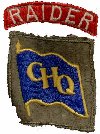

GHQ 1ST RAIDER COMPANY
8227th Army Unit
During World War Two, General Douglas MacArthur, Commanding General, Southwest Pacific Command, was not a great fan of Ranger/Raider or other special missions units. Even so, he authorized formation of the Alamo Scouts, a unit whose mission was to conduct raids, sabotage and reconnoiter behind enemy lines. The Alamo Scouts did well in this role but when the war ended, the unit disbanded so when North Korea invaded South Korea, 25 June 1950, no unit with Raider/Ranger or other special missions capability existed in the Far East Command. Or, for that matter, in the U.S. Army.
Given Korea was a peninsula with over a thousand miles of coast line, The staff at General Headquarters, Far East Command, Tokyo, quickly realized there was a need for an Alamo Scout-type unit so on 5 July 1950 formation a "provisional" Raider Company was authorized and designated, GHQ 1st Raider Company (Provisional.) The "Provisional" was dropped when the unit was designated the 8227th Army Unit.
Even with the authorization, finding men to form the new unit with was a problem since all combat units in Japan were deploying to Korea and needed their people so a call for volunteers went out to those assigned to Headquarters and Service Group, GHQ, Far East Command. Within days former clerks, cooks, drivers, supply and other support-type personnel began reporting to the 1st Raider Company, now located at Camp McGill outside of Yokosuka, Japan, where they began intensive training.
On 7 September 1950, Far East Command organized the Special Activities Group (SAG) and appointed Colonel Louis B. Ely to command the new unit. The 1st Raider Company became one of the groups units. The other units were: 41st Royal Marine Commando and the "UK and the Royal Navy Volunteer Group."
On 12 September 1950, the 1st Raider Company saw its first action. It was taken to Korea aboard the HMS Whitesands Bay, a British frigate, and landed on a small island at the mouth of Kunsan Bay (approximately 100 miles south of Seoul.) The mission was intended as a "deception ploy" to draw North Korean troops away from the Inchon area where an invasion was planned for 15 September 1950.
The raid at Kunsan did not go exactly as planned. Soon after landing the unit came under machine-gun fire but for some unknown reason grenades had not been issued so the machine-gun had to be engaged with ineffective rifle fire. During this battle three Raiders were killed: 1st Lt. James W. Clance, Corporal John W. Maines and Corporal Raymond E. Puttin. Clance and Maines were killed on the island and their bodies left behind when the unit was withdrawn because of heavy shellfire from artillery on the mainland. Puttin was evacuated to the HMS Whitesands Bay where he died of wounds a few hours later and was buried at sea. Corporal Maines body was recovered when the area was retaken by U.N. troops but Lt. Clances body had never been found. He is carried "Missing In Action."
Following their withdrawal from Kunsan, the 1st Raider Company proceeded to Inchon where they were to land by rubber boat on the Kimpo Peninsula and attack the airbase there. The mission was canceled when someone realized that it would be impossible to land using rubber boats because the tides and strong tidal currents in the Inchon area. As a result, the unit landed in the 36th Wave at Inchon, then proceeded toward Kimpo Airbase. The Marines had already taken Kimpo so the Raider Company was used as security and "clean up."
After the fall of Seoul, the 1st Raider Company was transferred to U.S. Tenth Corps (X-Corps) and later redesignated the" X-Corps Raider Company, 8245th Army Unit." The unit landed on Koreas East Coast with X-Corps where it conducted reconnaissance and intelligence missions. It was part of "Task Force Drysdale" which held open the passes while the Marines withdrew from the Chosin Reservoir in December 1950.
The Raider Company was disbanded in April 1951 when Department of the Army deactivated all "Ranger and Ranger-type units."